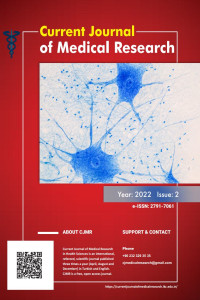Evaluation of the Relationship Between the Presence of Communicable Disease and Anxiety and Depression
Abstract
Objective: The psychosocial and economic effects of SARS-COV2 (COVID-19) are still considered to be problematic around the world. The effects of infection constitute a factor in the conducting study. The study aims to evaluate the psychological effects of individuals in infection.
Material and Methods: Due to social distancing measures during the COVID-19 pandemic, the survey and its answers were made online. There were 106 participants in the study and 58 out of 106
gave up-to-date answers. Personal Data Form, Beck Depression Scale and Beck Anxiety Scale were used. The replies were examined for socio-demographic fluxionals too. There were few sufferers in the groups, so fluxionals were converted to dual fluxionals and the Pearson chi-square test or Fisher’s Exact Test was used if the value was less in cells.
Results: 43,1 percent of the participants have no symptoms of depression, but 27.6% showed mild, 15.5% moderate, and 13.8% se-vere depression. 5.2% of the participants showed slight, 37.9% moderate, 27.6% severe anxiety symptoms, 29.3% had no symptoms. A significant difference was observed between having children, over 35 years of age and the severity of depression symptoms (p=0.001, p=0.006, respectively).
Conclusion: According to the results of the study, it was found that anxiety and depression symptoms improved/intensified in the existence of infectious disease.
Abstract
Amaç: Bildiğimiz üzere Türkiye’yi ve tüm dünyayı etkileyen SARS-COV2 (COVID-19) pandemisinin sağlık üzerine etkilerinin yanı sıra psikososyal ve ekonomik etkileri de güçlü ve sarsıcı olmuştur, olmaya da devam etmektedir. Hala varlığını sürdüren bu çapta büyük bir salgın ve bu salgının dünyayı saran olağandışı etkileri böyle bir çalışmayı yapmamızda etken olmuştur. Bu çalışmayla bulaşıcı hastalıklarda bireylerin psikolojik etkilenimlerinin değerlendirilmesi amaçlanmıştır.
Gereç ve Yöntemler: COVID-19 pandemisi sürecindeki sosyal mesafe önlemleri gereği araştırma anketi yalnızca çevrim içi ortam için hazırlanmış ve tüm anket yanıtları çevrim içi ortamdan elde edilmiştir. Bu çalışmaya uygun örnekleme yöntemi kullanılarak ulaşılan 106 katılımcı dâhil olmuştur. 106 katılımcıdan 58’i çalışmamız kapsamında geçerli yanıtlar vermiştir. Çalışmada Kişisel Bilgi Formu, Beck Depresyon Ölçeği ve Beck Anksiyete Ölçeği kullanılmıştır. Çalışmada aynı zamanda katılımcıların yanıtları sosyo-demografik değişkenler açısından da incelenmiştir. Gruplardaki vaka sayısının azlığı nedeniyle değişkenler ikili değişkenlere dönüştürülüp Pear-son ki-kare testi veya hücrelerde gereken sayının altında değer varsa Fisher’s exact test kullanılmıştır.
Bulgular: Katılımcıların %43,1’i depresyon semptom-ları göstermemiştir. Katılımcıların %27,6’sı hafif düzeyde, %15,5’i de orta düzeyde depresyon semptomları gösterirken %13,8’i ise şiddetli düzeyde göstermiştir. Katılımcıların %29,3’ü anksiyete semptomları göstermemiştir. Katılımcıların %5,2’si hafif düzeyde, %37,9’u orta düzeyde, %27,6’sı şiddetli düzeyde anksiyete semptomları göstermiştir. 35 yaşın üstünde ve çocuk sahibi olma ve depresyon semptomlarının şiddeti arasında anlamlı ilişki gözlenmiştir (sırasıyla p=0,001; p=0,006).
Sonuç: Çalışma sonucuna göre bulaşıcı hastalık varlığın-da bireylerde anksiyete ve depresyon semptomlarının geliştiği/ şiddetlendiği bulunmuştur.
Details
| Primary Language | Turkish |
|---|---|
| Subjects | Clinical Sciences |
| Journal Section | Research Articles |
| Authors | |
| Publication Date | August 30, 2022 |
| Submission Date | July 19, 2021 |
| Published in Issue | Year 2022 Volume: 2 Issue: 2 |


